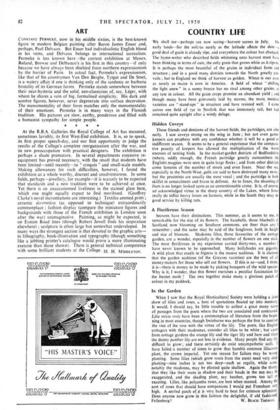ART
CONSTANT PERMEKE, now in his middle sixties, is the best-known figure in modern Belgian painting after Baron James Ensor and, perhaps, Paul Delvaux. But Ensor had individualistic English blood in his veins, and Delvaux belongs to international surrealism. Permeke is less known here —the current exhibition at Messrs. Roland, Browse and Delbanco's is his first in this country—if only because we have always been shielded from northern expressionism by the barrier of Paris. In actual fact, Permeke's expressionism, like that of his countrymen Van Den Berghe, Tytgat and De Smet, is a watery affair if one is thinking only of the sardonic or barbaric brutality of its German forms. Permeke stands somewhere between their near-hysteria and the solid, neo-classicism of, say, Leger, with whom he shares a vein of big, formalised simplicity. His dark and sombre figures, however, never degenerate into surface decoration. The monumentality of their form matches only the monumentality of their emotions. Permeke is in many ways in the Flemish tradition. His pictures are slow, earthy, ponderous and filled with a humanist sympathy for simple people.
At the R.B.A. Galleries the Royal College of Art has mounted, sometimes lavishly, its first West-End exhibition. It is, so to speak, its first proper speech-day, and our first opportunity to judge the results of the College's complete reorganisation after the war, and its new preoccupation with practical designers. The exhibition is perhaps a shade premature. In several departments extensive re- equipment has proved necessary, with the result that students have been limited—until recently—to " croquis " and small-scale models. Making allowances for such difficulties, however, I found the exhibition as a whole worthy, discreet and unadventurous. In some fields, perhaps—jewellery, for example—it is scarcely to be expected that standards and a new tradition were to be achieved at once. Yet there is an unaccustomed liveliness in the stained glass here, which one might equally expect to find moribund. (Geoffrey Clarke's novel incrustrations are interesting.) Textiles seemed prim ; ceramic decoration (as opposed to technique) extraordinarily commonplace ; fashion display (compare the miniature figures and backgrounds with those of the French exhibition in London soon after the war) unimaginative. Painting, as might be expected, is on Euston Road lines (though Robert Jewell finds his inspiration elsewhere) ; sculpture is often large but somewhat undeveloped. In many ways the strongest section is that devoted to the graphic arts— to lithography, book-illustration and typography,(though something like a jobbing printer's catalogue would prove a more illuminating exercise than those shown). There is general technical competence with some brilliant students at the College.
M. H. MIDDLETON.


































 Previous page
Previous page